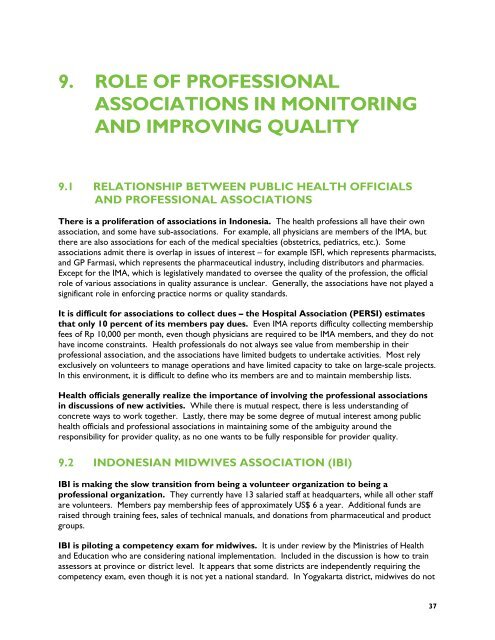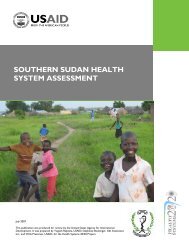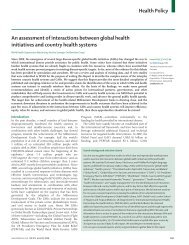PRIVATE SECTOR HEALTH CARE IN INDONESIA - Health Systems ...
PRIVATE SECTOR HEALTH CARE IN INDONESIA - Health Systems ...
PRIVATE SECTOR HEALTH CARE IN INDONESIA - Health Systems ...
- No tags were found...
Create successful ePaper yourself
Turn your PDF publications into a flip-book with our unique Google optimized e-Paper software.
9. ROLE OF PROFESSIONALASSOCIATIONS <strong>IN</strong> MONITOR<strong>IN</strong>GAND IMPROV<strong>IN</strong>G QUALITY9.1 RELATIONSHIP BETWEEN PUBLIC <strong>HEALTH</strong> OFFICIALSAND PROFESSIONAL ASSOCIATIONSThere is a proliferation of associations in Indonesia. The health professions all have their ownassociation, and some have sub-associations. For example, all physicians are members of the IMA, butthere are also associations for each of the medical specialties (obstetrics, pediatrics, etc.). Someassociations admit there is overlap in issues of interest – for example ISFI, which represents pharmacists,and GP Farmasi, which represents the pharmaceutical industry, including distributors and pharmacies.Except for the IMA, which is legislatively mandated to oversee the quality of the profession, the officialrole of various associations in quality assurance is unclear. Generally, the associations have not played asignificant role in enforcing practice norms or quality standards.It is difficult for associations to collect dues – the Hospital Association (PERSI) estimatesthat only 10 percent of its members pay dues. Even IMA reports difficulty collecting membershipfees of Rp 10,000 per month, even though physicians are required to be IMA members, and they do nothave income constraints. <strong>Health</strong> professionals do not always see value from membership in theirprofessional association, and the associations have limited budgets to undertake activities. Most relyexclusively on volunteers to manage operations and have limited capacity to take on large-scale projects.In this environment, it is difficult to define who its members are and to maintain membership lists.<strong>Health</strong> officials generally realize the importance of involving the professional associationsin discussions of new activities. While there is mutual respect, there is less understanding ofconcrete ways to work together. Lastly, there may be some degree of mutual interest among publichealth officials and professional associations in maintaining some of the ambiguity around theresponsibility for provider quality, as no one wants to be fully responsible for provider quality.9.2 <strong>IN</strong>DONESIAN MIDWIVES ASSOCIATION (IBI)IBI is making the slow transition from being a volunteer organization to being aprofessional organization. They currently have 13 salaried staff at headquarters, while all other staffare volunteers. Members pay membership fees of approximately US$ 6 a year. Additional funds areraised through training fees, sales of technical manuals, and donations from pharmaceutical and productgroups.IBI is piloting a competency exam for midwives. It is under review by the Ministries of <strong>Health</strong>and Education who are considering national implementation. Included in the discussion is how to trainassessors at province or district level. It appears that some districts are independently requiring thecompetency exam, even though it is not yet a national standard. In Yogyakarta district, midwives do not37
















